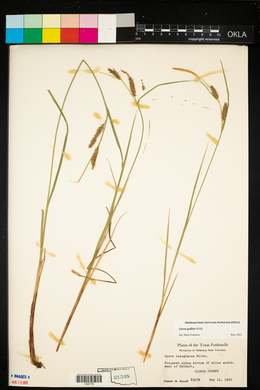Carex pellita
|
|
|
|
Family: Cyperaceae
Woolly Sedge
[Carex lanuginosa auct. non Michx., moreCarex lasiocarpa var. latifolia (Boeckl.) Gilly] |
Plants colonial; rhizomes long-creeping. Culms lateral, trigonous, 15-100 cm, smooth or slightly scabrous-angled. Leaves: basal sheaths reddish purple, usually fibrillose, bladeless, apex of inner band glabrous; ligules (1.2-)2-12 mm; blades green, flat or M-shaped except at base and tip, midvein of blades and proximal bracts forming sharply pointed keel, (2-)2.2-4.5(-6) mm wide, tip not prolonged, glabrous. Inflorescences 5-30 cm; peduncles of terminal spikes (0.8-)2-9 cm; proximal 1-3(-4) spikes pistillate, ascending; distal spikes erect; terminal 1-3 spikes staminate. Pistillate scales lanceolate to ovate, apex acute to acuminate-awned, glabrous or scabrous-margined apically. Perigynia ascending, broadly ovoid, 2.4-5.2 × 1.7-2.8 mm, densely pubescent, obscuring cellular details and veination; beak (0.6-)0.8-1.6 mm, firm, bidentulate, teeth straight, 0.4-0.8 mm. 2n = 78. Fruiting May-Aug. Wet to dry meadows, marshes, stream banks, lakeshores, open carrs and woodlands, low dunes, ditches, and other usually moist, successional habitats, especially in regions of calcareous soils; 0-2900 m; Alta., B.C., Man., N.B., Nfld. and Labr. (Nfld.), Ont., Que., Sask., Yukon; Alaska, Ariz., Ark., Calif., Colo., Conn., Del., Idaho, Ill., Ind., Iowa, Kans., Ky., Maine, Md., Mass., Mich., Minn., Mo., Mont., Nebr., Nev., N.H., N.J., N.Mex., N.Y., N.Dak., Ohio, Oreg., Pa., R.I., S.Dak., Tex., Utah, Vt., Va., Wash., W.Va., Wis., Wyo.; Mexico. Carex pellita is abundant and variable in much of its range and a common plant of roadside ditches and other early successional or disturbed habitats. It is sometimes subsumed under C. lasiocarpa, as var. latifolia (Boeckeler) Gilly, but it is distinct in the field and has a quite different biology and distribution. However, slender and depauperate individuals can be difficult to distinguish in the herbarium. The name Carex lanuginosa has been used for this species in many floras, but the type of this name is C. lasiocarpa. Carex pellita hybridizes occasionally with C. hyalinolepis (= C. ×subimpressa) and rarely with C. lacustris, C. trichocarpa (= C. ×caesariensis, A. A. Reznicek and P. M. Catling 1985), and C. utriculata.
Vigorously colonial by creeping rhizomes, 3-10 dm, strongly aphyllopodic; lvs flat or nearly so, 2-5 mm wide; terminal spike staminate, 2-5 cm, often closely subtended by one or 2 shorter, sessile staminate spikes; pistillate spikes 2 or 3, 1-4 cm, rather remote, sessile or the lowest one on an erect slender peduncle, leafy-bracteate, the lowest bract elongate, often surpassing the staminate spikes; pistillate scales partly or wholly brownish or purplish, usually narrower than the perigynia and acute or shortly awn- tipped; perigynia 3-3.5 mm, densely velutinous or velutinous-sericeous, multiribbed, but the ribs ±obscured by the pubescence, the body ovoid to broadly ellipsoid or subglobose, turgid, not much compressed, firm, abruptly contracted to the beak, this 0.8-1.5 mm, including the 0.3-0.9 mm teeth; achene concavely trigonous. Wet meadows and other wet places, sometimes in shallow water, or seldom on stabilized dunes or dry ditch- banks; N.B. and Que. to B.C., s. to Va., Tenn., Ark., and Calif. (C. lanuginosa, misapplied) Gleason, Henry A. & Cronquist, Arthur J. 1991. Manual of vascular plants of northeastern United States and adjacent Canada. lxxv + 910 pp. ©The New York Botanical Garden. All rights reserved. Used by permission. From Flora of Indiana (1940) by Charles C. Deam Common in northern Indiana in swamps, sloughs, wet ditches, open swampy woods, and on lake borders; infrequent in southern Indiana. This, like the following species, is usually plentiful where found, often being the dominant plant in a marsh or on a lake border. It is one of the most widely distributed sedges in North America. Schneck's report from the Lower Wabash Valley is unsupported by specimens; in fact, no material has been seen from any of the southwestern counties. ...... Indiana Coefficient of Conservatism: C = 2 Wetland Indicator Status: OBL |
|
|
|




































































































